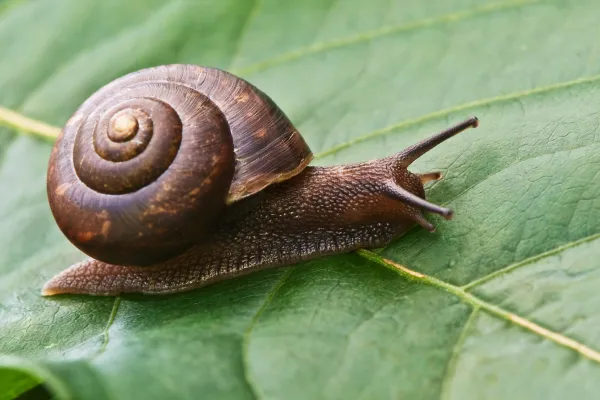Visible to the naked eye due to their characteristic shell and soft, sticky body, land snails belong to the phylum Mollusca and the class Gastropoda, the most diverse and largest class of mollusks. The development of lungs has allowed them to colonize land, occupying diverse environments where they feed primarily on plant species. Would you like to learn more about land snails? Then don't miss the following article, where we'll tell you what land snails are, their characteristics, and types.

Land snails are pulmonate invertebrates that, due to their characteristics, belong to the phylum Mollusca and the class Gastropoda. Within this class, most land snails are in the order Stylommatophora, also known as stylomatophorans.
One of the distinctive characteristics of land snails is that they have developed lungs and lost their gills. This allowed them to perform aerial respiration, a fundamental adaptation for their transition to the terrestrial environment.
They have lost their primitive gills, but their vascularized mantle wall has transformed into a lung. The air inlet and outlet is called a pneumostome.
They have hard, univalve shells that contain their internal organs and provide protection against dehydration and predators.
Some species, such as those belonging to the family Clausiliidae, have a calcareous structure called a clausilia, which allows them to close the shell opening, protecting the soft parts of the snail.
They have a flat muscular foot with mucus-secreting glands that help them move and grip different surfaces.
They have two pairs of tentacles, and the eyes are located on the posterior pair.
They have a mantle, a double integumentary fold that covers and provides protection to the visceral mass that contains the different organ systems.
Common garden snail (Cornu aspersum): Native to the European continent, it has been introduced to various regions of other countries, acting as an invasive species in agricultural crops. It is highly valued in Mediterranean cuisine.
Land snail (Rumina decollata): Native to the Mediterranean and North Africa, this is an omnivorous species, as it not only feeds on plants but also preys on garden snails, slugs, and their eggs.
Helicella stiparum: Characterized by its solid white shell, it survives in dry soils with xerophytic vegetation in the province of Almería, Spain.
Gate snail (Megalophaedusa martensi): Endemic to Japan, it is the largest living member of the Clausiliidae family in the world.
Giant tiger snail (Achatina achatina): Native to West Africa, it can grow up to 18 centimeters, making it one of the largest known snails in the world.
Plagiodontes rocae: Endemic to the southwest of the Buenos Aires province in Argentina, in the mountain range known as the "Sierra de la Ventana."
Land snails find their habitat determined by various factors, such as the mineral composition of the soil, humidity, temperature, and high acidity. Although they prefer humid and shady places, it is surprising that some species defy these limitations, living at high altitudes and in seemingly inhospitable regions. Their most frequent habitats are linked to environments such as forests, roadsides, grasslands, and open areas. They have also managed to adapt to urban contexts, settling in vegetated nooks formed by leaf debris, under tree trunks, roots, or in depressions in the ground.
Certain species have managed to survive in xerophilous environments, calcareous soils, and volcanic soils. These species usually hide under stones, among withered cacti, or even among grass roots. Furthermore, their adaptability extends to aquatic environments, such as the banks of streams and rivers, as well as on the sides of mountains.
In short, the diversity of habitats that land snails have colonized is an impressive testament to their ability to find refuge in a wide range of environmental conditions.
Although feeding habits can vary, as some species are omnivorous and can feed on both plants and other mollusks, land snails are generally herbivorous, and their radula is adapted to feed on different plant species at night. Some species, such as Cornu aspersum, which has been introduced outside its original range, behave as invasive alien species and are often associated with productive crops, generating large economic losses.
The structure of snail shells, like their egg covers, is primarily composed of calcium carbonate, so snails depend on the availability of calcium in their diet to develop strong, sturdy shells. Insufficient calcium or variations in the pH level in their habitat can have detrimental effects, such as the formation of thin shells, cracks, or even perforations in the shells.
Land snails are hermaphrodites and produce both eggs and sperm. Copulation generally occurs, preceded by a complex courtship display, with sperm transfer using spermatophores. In snails of the Helicidae family, the vagina secretes a calcareous spicule. When two snails "embrace," one thrusts this dart into the other's body. This process may be linked to a stimulating action, leading one individual to act as a male and the other as a female, since the spicule does not carry sex cells. After this complex courtship display, a spermatophore is transferred from the male sexual organ of one individual to the female sexual organ of the other, where sperm are released and the eggs are subsequently fertilized.
Terrestrial species are oviparous and produce a small number of eggs, which are wrapped in albumen and have their own protective capsule that serves as a source of calcium for the formation of the shell. The eggs are laid on the ground in small groups.
Now that you know what land snails are, their characteristics, and types, you might also be interested in these articles on the Parts of a Snail and How Long a Snail Lives.
If you want to read similar articles to Land Snails: What They Are, Characteristics, and Types, we recommend you visit our Wild Animals category.
animal tags: snails
We created this article in conjunction with AI technology, then made sure it was fact-checked and edited by a Animals Top editor.